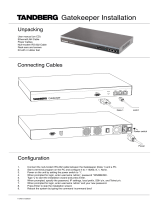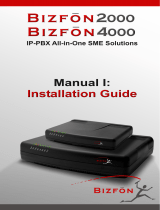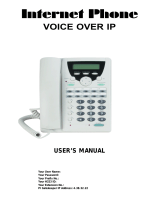Page is loading ...

1

FCC Notice
This equipment has been tested and found to comply with the limits for a Class
B digital device, pursuant to Part 15 of FCC Rules. These limits are designed
to provide reasonable protection against harmful interference when the
equipment is operated in a commercial environment. This equipment generates,
uses, and can radiate radio frequency energy and, if not installed in accordance
with the instruction manual, may cause harmful interference to radio
communication. Operation of this equipment in a residential area is likely to
cause harmful interference in which case the user will be required to correct
the interference at the user’s own expense.
CE Declaration of conformity
This equipment complies with the requirements relating to electromagnetic
compatibility, EN 55022 class A for ITE and EN 50082-1. This meets the
essential protection requirements of the European Council Directive
89/336/EEC on the approximation of the laws of the Member States relating to
electromagnetic compatibility.
Trademarks
All brand, company and product names are trademarks or registered
trademarks of their respective companies.
Copyright Statement
No part of this publication may be reproduced, stored in a retrieval system, or
transmitted in any form or by any means, whether electronic, mechanical,
photo copying, recording, or otherwise without the prior writing of the
publisher.
May. 2005
2

Setup
How to Use This Manual
This manual was designed for the non-technical users of the VoIP Gateway (TVP-
224HR). It contains information about the functions of the TVP-224HR and
instructions for its installation, basic configuration and operation. Read this
section carefully for important information about the manual’s organization.
Important Safety Instructions
Before you plug the TVP-224HR into an electrical outlet, carefully read all the
installation instructions in Chapter 2.
For your own safety and the safety of your equipment, always take the following
precautions:
• Follow instructions and warnings in the documentation.
• Never push any object through the fan vent or other openings in the
equipment. Such action may produce a short circuit, causing fire,
electric shock, or equipment damage.
• Keep the TVP-224HR away from all chemicals and sources of liquids.
Warning
• Connection of the RJ45 connector from a TVP-224HR to TNV circuits can
cause permanent damage to the TVP-224HR.
• Incorrectly connecting telephony devices to the RJ11 port on the
Telephony Interface Module
can cause permanent damage to the module.
3

Documentation Abbreviations
Throughout this guide, the user will come across a number of abbreviations that
are common throughout the industry. The user should be familiar with the
following abbreviations:
ATPM
Address Translation and Parsing Manager
CLI
Command Line Interface
DSP
Digital Signal Processor
DTMF
Dual Tone Multi-Frequency
FXO
Foreign Exchange Office
FXS
Foreign Exchange Station
H.323
ITU specification for multimedia transmission over IP
networks
ICMP
Internet Control Message Protocol
IMTC
International Multimedia Telecommunications
Consortium
IP
Internet Protocol
TVP-221H
4-port VoIP Gateway
TVP-224HR
4-port VoIP Gateway Router
KTS
Key Telephone System
LAN
Local Area Network
NVS
Non-Volatile Storage
LED
Light Emitting Diode
PBX
Private Branch Exchange
PSTN
Public Switched Telephone Network
RTP
Real-Time Transport
TCID
Telephony Channel Identifier
TFTP
Trivial File Transfer Protocol
TIM
Telephony Interface Modules
TNV
Telephone Network Voltage
UDP
User Datagram Protocol
UTP
Unshielded Twisted Pair
VAD
Voice Activity Detection
WAN
Wide Area Network
4

Setup
Notation Conventions
Throughout this guide, different type styles and characters are used. These serve a
variety of purposes as described below:
Convention Description
boldface Commands and keywords are in boldface.
italic Arguments for which you supply values are in
italics.
courier Messages that the TVP-224HR CLI displays are in
plain courier font.
[ ] Elements in square brackets are optional.
{ x | y | z } Alternative but required elements are grouped in
braces ({ }) and separated by vertical bars ( | ).
[ x | y | z ] Optional alternative keywords are grouped in
brackets ([ ]) and separated by vertical bars ( | ).
string A non-quoted set of characters. Do not use quotation
marks around the string or the string will include the
quotation marks.
key A key on the VT-100 terminal of terminal emulator.
For example
<Enter> denotes the Enter key
5

Table of Contents
How to Use This Manual ..........................................................................................................3
Important Safety Instructions..................................................................................................3
Documentation Abbreviations .................................................................................................4
Notation Conventions................................................................................................................5
CHAPTER 1 .........................................................................................12
OVERVIEW ...........................................................................................12
1.1 Features........................................................................................................................12
Internet Access Features........................................................................................................ 13
Advanced Internet Functions ................................................................................................ 13
LAN Features ........................................................................................................................ 13
Configuration & Management .............................................................................................. 13
Security Features................................................................................................................... 13
1.2 Networking Protocols..................................................................................................14
1.3 Package Contents........................................................................................................14
1.4 Front Panel ..................................................................................................................14
LED Indicators...................................................................................................................... 15
Reset Button .......................................................................................................................... 15
1.5 Rear Panel....................................................................................................................15
WAN / LAN / Console Ports ................................................................................................ 16
Console.................................................................................................................................. 16
CHAPTER 2 .........................................................................................17
INSTALLING THE TVP-224HR...........................................................17
2.1 Network Requirements...............................................................................................17
2.2 Installing the TVP-224HR..........................................................................................17
2.3 Connecting to the telephony devices..........................................................................17
2.4 Connecting to the LAN Network ...............................................................................17
2.5 Assigning an IP address to the TVP-224HR.............................................................18
2.6 Hardware Installation Procedures.............................................................................18
6

Setup
CHAPTER 3 .........................................................................................20
ROUTER SETUP ...................................................................................20
Overview ..................................................................................................................................20
Configuration Program..........................................................................................................21
Preparation ............................................................................................................................ 21
Home Screen ......................................................................................................................... 22
LAN Configuration.................................................................................................................24
DHCP .................................................................................................................................... 25
CHAPTER 4 PC CONFIGURATION .....................................................26
Overview ..................................................................................................................................26
Windows Clients......................................................................................................................26
TCP/IP Settings - Overview.................................................................................................. 26
Checking TCP/IP Settings - Windows 9x/ME:..................................................................... 27
Checking TCP/IP Settings - Windows NT4.0....................................................................... 29
Checking TCP/IP Settings - Windows 2000:........................................................................ 32
Checking TCP/IP Settings - Windows XP............................................................................ 34
Internet Access ...................................................................................................................... 36
Macintosh Clients....................................................................................................................37
Linux Clients............................................................................................................................37
Other Unix Systems.................................................................................................................37
CHAPTER 5 OPERATION AND STATUS.............................................38
Operation.................................................................................................................................38
System Status Screen ..............................................................................................................38
CHAPTER 6 INTERNET FEATURES.....................................................41
Overview ..................................................................................................................................41
Internet Access Configuration ...............................................................................................41
Fixed / Dynamic IP Address...................................................................................................41
PPPoE Configuration..............................................................................................................43
Special Applications.............................................................................................................. 44
DMZ...................................................................................................................................... 45
Dynamic DNS (Domain Name Server)..................................................................................45
Dynamic DNS Screen ........................................................................................................... 46
7

Virtual Servers / Port Forwarding ........................................................................................47
IP Address seen by Internet Users......................................................................................... 47
Virtual Servers Screen........................................................................................................... 48
Connecting to the Virtual Servers ......................................................................................... 48
Voice QoS.................................................................................................................................49
Voice QoS Screen ................................................................................................................. 49
CHAPTER 7 ADMINISTRATION ........................................................51
Overview ..................................................................................................................................51
Administration Password Setup / Login ...............................................................................51
Remote Administration ..........................................................................................................52
Upgrade Firmware..................................................................................................................54
Access Control.........................................................................................................................55
Access Control Screen ..........................................................................................................56
Common Port Assignment .................................................................................................... 57
CHAPTER 8 .........................................................................................61
TVP-224HR TELEPHONY CONCEPTS ...............................................61
8.1 How the TVP-224HR Operates..................................................................................61
8.2 ATPM...........................................................................................................................61
8.3 Destination ...................................................................................................................61
8.4 Hunt Group..................................................................................................................62
8.5 Dial Plan.......................................................................................................................62
Address Table........................................................................................................................ 62
Hunt Group Table ................................................................................................................. 63
Destination Table .................................................................................................................. 63
8.6 DTMF Relay ................................................................................................................63
8.7 Voice Codecs................................................................................................................64
CHAPTER 9 .........................................................................................65
CONFIGURING VOIP FROM A WEB BROWSER ..................................65
9.1 HTTP setting mode .....................................................................................................65
Main Menu Function Briefings............................................................................................. 66
System Status ........................................................................................................................ 67
8

Setup
9.2 H.323 Configuration ...................................................................................................67
H.323 Status Page ................................................................................................................. 67
H.323 Parameters .................................................................................................................. 68
Gatekeeper............................................................................................................................. 69
Aliases ................................................................................................................................... 71
9.3 Dial Plan Settings ........................................................................................................73
Dial Plan Setup...................................................................................................................... 73
Telephone Number Table...................................................................................................... 73
Hunt Group Table ................................................................................................................. 74
Destination ID Table ............................................................................................................. 75
9.4 Dial in PLAR / CID.....................................................................................................76
Dial in PLAR Considerations and Limitations...................................................................... 77
9.5 Store Dial Plan.............................................................................................................77
9.6 Clear Dial Plan ............................................................................................................77
9.7 Restore Dial Plan.........................................................................................................78
9.8 Line Settings.................................................................................................................78
Channel Status....................................................................................................................... 78
Codec Selection..................................................................................................................... 78
Common Parameters ............................................................................................................. 78
Total Time............................................................................................................................. 79
First Digit Wait Time ............................................................................................................ 79
Inter Digit Wait Time............................................................................................................ 79
Termination Digit.................................................................................................................. 79
9.9 Channel Parameters....................................................................................................79
9.10 Administration............................................................................................................79
Password (See Chapter 7) ..................................................................................................... 79
Telnet Access ........................................................................................................................ 80
Interface Speed...................................................................................................................... 80
9.11 Channel Status............................................................................................................80
9.12 Help..............................................................................................................................80
CHAPTER 10 .......................................................................................81
MAKING CALLS WITH TVP-224HR ...................................................81
10.1 Configuration Examples.............................................................................................81
Default Dial Plan................................................................................................................... 81
10.2 Making a call with TVP-224HR FXS Port................................................................82
10.3 Making a call with TVP-224HR FXO Port...............................................................83
10.4 Web Browser Sample Dial Plan.................................................................................83
9

10.5 Making a call between Gateway A and Gateway B..................................................90
Case 1: Gateway Phone to Gateway Phone.......................................................................... 90
Case 2: Gateway Phone to PSTN Phone.............................................................................. 91
Case 3: PSTN Phone to Gateway Phone.............................................................................. 92
10.6 VoIP in a Dynamic IP environment...........................................................................92
10.7 PPPoE, DHCP, and DDNS clients:............................................................................93
Case 4: Gateway Prefix–Simplified Gateway Phone to Gateway Phone............................. 93
10.8 Dial in PLAR (Hotline) – TVP-224HR / TVP-224HR............................................100
Case 5: PLAR (Hotline) FXO to FXS example ................................................................. 100
Case 6: PLAR (Hotline) FXS to FXO example ................................................................. 103
Case 7: PLAR (Hotline) FXO to FXO example................................................................. 105
CHAPTER 11 .....................................................................................107
TELEPHONY CONNECTIONS............................................................107
11.1 Port Configuration....................................................................................................107
Application 1: Special FXS Connections............................................................................ 108
Application 2: FXO Connections........................................................................................ 108
CHAPTER 12 .....................................................................................109
TROUBLESHOOTING TIPS................................................................109
Overview ................................................................................................................................109
General Problems..................................................................................................................109
Internet Access ......................................................................................................................109
Other Problems .....................................................................................................................110
Appendix A - Technical Specifications................................................................................111
TVP-224HR Technical Specifications ................................................................................ 111
Console Port........................................................................................................................ 113
LAN Port............................................................................................................................. 113
FXO Port Pin Assignments ................................................................................................. 114
FXS Port Pin Assignments.................................................................................................. 114
Appendix B - Connecting through Console ........................................................................115
Appendix C - Connecting through Telnet...........................................................................116
Appendix D - CLI Commands.............................................................................................118
Normal Mode Commands ................................................................................................... 118
Download Mode Commands............................................................................................... 119
Appendix E - Factory Default Settings................................................................................120
10

Setup
Appendix F - Worksheets.....................................................................................................122
IP Parameters ...................................................................................................................... 122
ATPM Destination Table .................................................................................................... 122
Remote Destinations ........................................................................................................... 123
ATPM Hunt Group Table ................................................................................................... 124
ATPM Address Table ......................................................................................................... 125
Index.......................................................................................................................................126
11

1
Chapter 1
Overview
This chapter gives an overview of the 4 ports desktop version VoIP Gateway Router (TVP-
224HR) and a detailed description of its front panel and rear panel.
Congratulations on the purchase of your new TVP-224HR. The TVP-224HR is a multi-
function device providing the following services:
Shared Broadband Internet Access for all LAN users.
Figure 1: TVP-224HR
1.1 Features
The TVP-224HR is a cost-effective and highly reliable analog Voice over IP
(VoIP) Gateway Router that offers toll quality voice and real-time fax data over IP
networks. With its embedded architecture, the gateway is ideal for VoIP
applications associated with Remote Office and Branch Office (ROBO)
environments. With its built-in user-friendly interface, the gateway may be
installed easily and conveniently to yield immediate cost savings. One VoIP
Gateway supports up to four voice or Fax communications simultaneously.
Implemented with an efficient Real-Time Operating System (RTOS) and flash
memory, the TVP-224HR provides upgradeable capabilities, so it may be
programmed with updated firmware locally or via the network at any time. It
comes equipped with remote management capabilities, configurable signaling to
work with PBX, KTS, and/or telephone. The TVP-224HR utilizes advanced VoIP
related technology. It includes various voice codecs and fax algorithms, echo
cancellation, Voice Activity Detection (VAD) , Comfort Noise Generation
(CNG) , and lost packet recovery algorithms.
12

Setup
Internet Access Features
• Shared Internet Access. All users on the LAN or WLAN can access the Internet
through the TVP-224HR, using only a single external IP Address. The local (invalid)
IP Addresses are hidden from external sources. This process is called NAT (Network
Address Translation).
•
DSL & Cable Modem Support. The TVP-224HR has a 100BaseT Ethernet port
for connecting a DSL or Cable Modem. All popular DSL and Cable Modems are
supported. SingTel RAS and Big Pond (Australia) login support is also included.
•
PPPoE. The Internet (WAN port) connection supports PPPoE (PPP over
Ethernet).
•
Fixed or Dynamic IP Address. On the Internet (WAN port) connection, the TVP-
224HR supports both Dynamic IP Address (IP Address is allocated on connection)
and Fixed IP Address.
Advanced Internet Functions
• Special Internet Applications. Applications which use non-standard connections
or port numbers are normally blocked by the Firewall. The ability to define and allow
such applications is provided, to enable such applications to be used normally.
•
Virtual Servers. This feature allows Internet users to access Internet servers on your
LAN. The required setup is quick and easy.
•
DMZ. One (1) PC on your local LAN can be configured to allow unrestricted 2-way
communication with Servers or individual users on the Internet. This provides the
ability to run programs which are incompatible with Firewalls.
• QOS. This feature “guarantees” better service to selected traffic on a network. The
goal in configuring QoS is to give priority and attention to certain devices or services
so that they can use the maximum available throughput and speed available on a
certain network when it is needed.
LAN Features
• DHCP Server Support. Dynamic Host Configuration Protocol provides a dynamic
IP address to PCs and other devices upon request. The TVP-224HR can act as a
DHCP Server for devices on your local LAN and WLAN.
Configuration & Management
• Easy Setup. Use your WEB browser from anywhere on the LAN or WLAN for
configuration.
•
Remote Management. The TVP-224HR can be managed from any PC on your
LAN. And, if the Internet connection exists, it can also (optionally) be configured via
the Internet using a web browser or telnet.
Security Features
• Password - protected Configuration. password protection is provided to prevent
unauthorized users from modifying the configuration data and settings.
•
NAT Protection. An intrinsic side effect of NAT (Network Address Translation)
technology is that by allowing all LAN users to share a single IP address, the location
and even the existence of each PC is hidden. From the external viewpoint, there is no
network, only a single device - the TVP-224HR.
13

1.2 Networking Protocols
The TVP-224HR supports several industry-standard networking protocols
required for voice communication. The following table describes these protocols.
Networking Protocol Description
Internet Protocol (IP) IP is a messaging protocol that addresses and sends packets
across the network. To enable IP protocol, the TVP-224HR
must have a Real IP address, subnet, and gateway assigned
to it.
Voice over IP Protocol
(VoIP)
VoIP enables the TVP-224HR to transfer voice
communications over an IP network. The TVP-224HR
employs ITU-T H.323 protocol for setting up calls with
one another.
Trivial File Transfer
Protocol (TFTP)
TFTP allows you to transfer files over the network. The
TVP-224HR implements a TFTP client allowing you to
download new revision firmware from a TFTP server. The
TFTP client requires a TFTP server in your network.
Real-Time Transport
(RTP)
RTP is a standard for transporting real-time data over IP
network. The TVP-224HR uses RTP protocol to send
digitized and compressed voice packets.
1.3 Package Contents
The contents of your product should contain the following items:
• TVP-224HR VoIP Gateway Router 4 port n
• 100-240V Power Adapter
• 9-pin straight through RS-232 cable
• Printed Quick Installation Guide
• User’s guide (CD)
• RJ45 Cable
1.4 Front Panel
The front panel of the TVP-224HR contains a push button and LED indicators.
The following figure illustrates the front panel of the TVP-224HR.
4-port TVP-224HR Front Panel
14

Setup
LED Indicators
The LED indicators on the front panel display the current status of the TVP-224HR
as described in the following table:
Indicator Color Activity Indication
PWR Green On Power is supplied to the gateway.
SYSTEM Green Blinking The system is running. (Heartbeat LED)
LAN
Act
Link
WAN
Link
Act
Green
Green
Green
Green
On
On
Off
On
On
Data is being transferred on the LAN.
The gateway is connected to LAN at 100Mb/s.
The gateway is connected to LAN at 10Mb/s.
The gateway is connected to WAN.
Data is being transferred on the WAN.
LINE
Channels
1-4
Green Off
On
Blinking
The line is idle.
The line is being used.
The line is ringing.
Reset Button
There is a recessed push button located next to the SYSTEM LED. This button
allows you to reset the TVP-224HR or force the TVP-224HR to enter firmware
upgrade mode.
To reset the gateway, push a small, stiff object into the hole until the SYSTEM
LED stops blinking, then release the button.
Powering on the gateway while pressing down the button for 5 seconds forces the
TVP-224HR to enter download mode
1.5 Rear Panel
The rear panel of the TVP-224HR has four analog telephony ports, two FXO and
two FXS ports offering flexible telephony interface usage. The FXS telephony
interface ports may be connected to Subscriber Equipment, such as Telephones,
Fax Machines, Cordless Phones, and Modems. FXO ports can be connected to
PBX and local phone company Central Office (CO) lines. In addition to analog
telephony interface ports, there is a power jack for power adapter connection on
the rear panel.
15

4-port TVP-224HR Rear Panel
WAN / LAN / Console Ports
The TVP-224HR is equipped with 1 WAN and 4 LAN Ethernet interfaces with
10/100 Mbps auto-negotiation, auto MDIX capability. The Ethernet ports are
located on the rear panel.
Console
There is a 9-pin RS-232 interface port on the front panel. Their functions are
described below:
Port Label Function
1x RJ45 WAN Connecting to Cable / ADSL Modem
for Internet connection.
4x RJ45 LAN Connecting the TVP-224HR to 10/100
Mbps Ethernet network
9-pin RS-232 User Console Connecting the TVP-224HR to a VT-
100 terminal or terminal emulator for
configuring the TVP-224HR
16

Setup
2
Chapter 2
Installing the TVP-224HR
This chapter gives information on how to install the TVP-224HR.
2.1 Network Requirements
For the TVP-224HR to successfully operate in your network, your network must
meet the following requirements:
1. A working 10/100 Base-T Ethernet. The TVP-224HR connects to the Internet
via an Ethernet LAN.
2. IP network that supports gateway, and subnet mask. You’ll need a static IP
address to assign the TVP-224HR or a DDNS account for your Dynamic IP.
2.2 Installing the TVP-224HR
Due to the TVP-224HR being used in a desktop configuration, ensure that the
TVP-224HR is placed in a clean, well-ventilated, and vibration-free environment.
When the TVP-224HR is used, be certain that the unit is placed on a sturdy, flat
surface, near a grounded power outlet. At least three inches of clearance must be
provided on both sides of the TVP-224HR for good ventilation.
2.3 Connecting to the telephony devices
The 4 port TVP-224HR supports 2 FXO and 2 FXS. Each RJ11 port is for
connecting to telephony devices.
The FXO port is designed for connecting to PBXs or local telephone company
central office switches (CO).
The FXS port is designed for connecting to analog telephone sets, G3 fax
machines.
Warning: connection of incorrect telephony devices to the ports on the TIM can
cause permanent damage to the TIM and/or the TVP-224HR.
2.4 Connecting to the LAN Network
The 4x RJ45 LAN network ports on the rear panel supports 10/100 Mbps half-
duplex connections to Ethernet. You can use either Category 3 or 5 straight-
through UTP cable for 10 Mbps connections, but use Category 5 for 100 Mbps
connections. Insert one end of the Ethernet cable into one of the 4 RJ45 ports on
the rear panel of the TVP-224HR and other end of the cable to a network device /
PC.
17

2.5 Assigning an IP address to the TVP-224HR
The IP address is the unique logical address identifying each IP node, such as the
TVP-224HR, on an IP network. An IP address is a 32-bit number expressed as
four decimal numbers from 0 to 255 separated by periods. The TVP-224HR can
be configured with a fixed IP address, subnet mask and default gateway. The
TVP-224HR can also be setup as a DHCP. Additionally, the TVP-224HR can also
be configured to use PPPoE. With PPPoE, you will have a Dynamic IP but
combined with Dynamic DNS, the TVP-224HR will automatically notify
DynDNS of your changing IP Address and DynDNS will in turn, map it to your
registered Domain Name. Consult your network manager to obtain a unique and
static IP address for the TVP-224HR, the IP subnet mask and default gateway of
your network, and fill out the work sheet in Appendix D before configuring the
gateway. Procedures for assigning IP address, default gateway and subnet mask is
available in Chapter 4.
2.6 Hardware Installation Procedures
1. Choose an Installation Site
• Select a suitable place on the network to install the TVP-224HR.
Ensure the TVP-224HR and the DSL/Cable modem are powered OFF.
2. Connect LAN Cables
• Use standard LAN cables to connect PCs to the Switching Hub ports on the TVP-
224HR. Both 10BaseT and 100BaseT connections can be used simultaneously.
• If required, you can connect any LAN port to another Hub. Any LAN port on the
TVP-224HR will automatically function as an "Uplink" port when required. Just
connect any LAN port to a normal port on the other hub, using a standard LAN cable.
• If desired, connect a PC (server) to the DMZ port. To use multiple servers, use a
standard LAN cable to connect the DMZ port to a normal port on another hub, and
connect your servers to the hub. PCs connected to the DMZ port are isolated from
your LAN.
3. Connect WAN Cable
• Connect the Broadband modem to the WAN port on the TVP-224HR.
Use the cable supplied with your Broadband modem. If no cable was
supplied, use a standard LAN cable.
4. Power Up
• Power on the Broadband modem.
• Connect one end of the power cord that came with the TVP-224HR to the
power jack on the rear panel.
• Connect the other end of the power cord to an AC power outlet.
• The TVP-224HR will execute memory and application code testing
automatically.
• Use only the power adapter provided. Using a different one may cause hardware
damage
18

Setup
5. Check the LEDs
• The Power LED should be ON.
• The Systems LED should be blinking.
• For each LAN (PC) connection, the LAN Link/Act LED should be ON (provided the
PC is also ON.)
• The WAN LED should be ON.
• For each telephony device connection, the Line LED should be ON (provided
the device is plugged in and receiver is off hook.)
19

3
Chapter 3
Router Setup
This Chapter provides Setup details of the TVP-224HR.
Overview
This chapter describes the setup procedure for:
• Internet Access
• LAN configuration
PCs on your local LAN may also require configuration. For details, see Chapter 4 - PC
Configuration.
Other configuration may also be required, depending on which features and functions of the
TVP-224HR you wish to use. Use the table below to locate detailed instructions for the
required functions.
To Do this: Refer to:
Configure PCs on your LAN. Chapter 4:
PC Configuration
Check TVP-224HR operation and Status. Chapter 5:
Operation and Status
Use any of the following Internet features:
Internet Access Configuration
Dynamic DNS (Domain Name Server)
Special Applications
Virtual Servers
Port Fowarding
DMZ
QoS
Chapter 6:
Internet Features
Change any of the following Administration-related
settings:
Admin Login
Access Control
Remote Administration
Upgrade Firmware
Chapter 7:
Administration
Where use of a certain feature requires that
PCs or other LAN devices be configured, this
is also explained in the relevant chapter.
20
/



